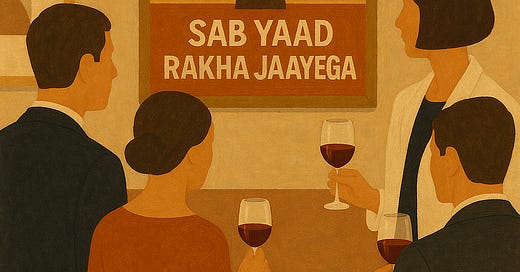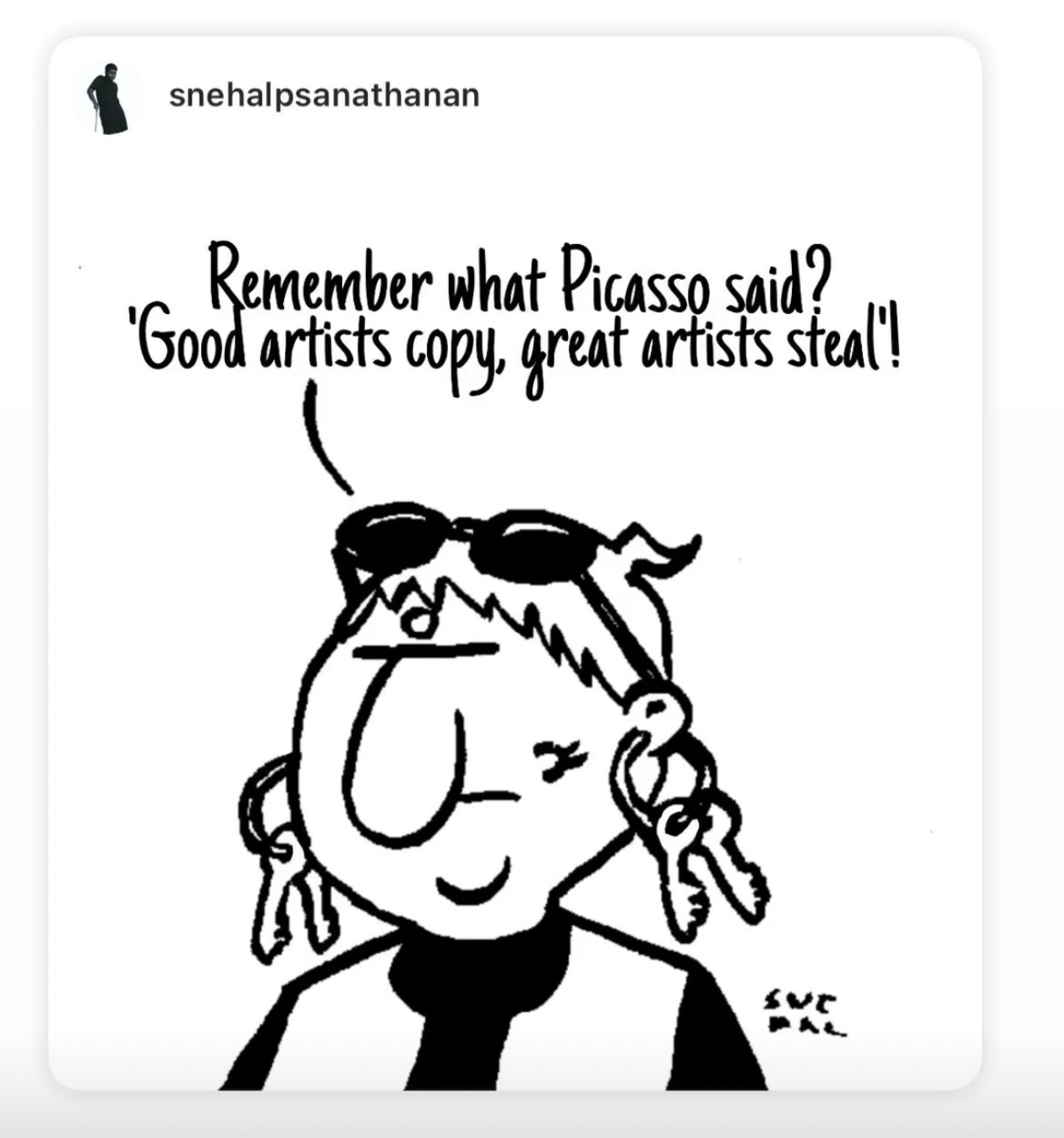The Art of Stealing Like an Artist
Poet Aamir Aziz alleges an artist from gallery stole his political poem
Last night, the art world where theft is called tribute and boredom is called depth gave us another tragic comedy. A gallery artist, Anita Dube, who perhaps removed a ‘Y’ in her name to not sound like any other privileged caste Dubey, was accused of lifting a poem by poet Amir Aziz. Yes, that poem which everyone knows of. The one chanted in the streets during the anti-CAA protests, when resistance smelled of sweat and not Chanel No. 5 perfumes at art galleries. This poem was allegedly stolen by the artist in her work without the consent from original artist. If it is true then this might be perhaps the first manual theft in the era of digital ChatGPT driven art theft. And maybe, just maybe, we should at least appreciate the lost art of analog stealing.
Amir Aziz accused the internationally recognised artist of lifting his poem without consent and turning it into a commodity. The lines: “Aur tum adalaton se baith kar chutkule likho, hum sadkon deewaron pe insaf likhenge” were originally meant to bleed on protest walls. Instead, they were now embroidered on velvet, a fabric historically reserved for kings and couches, and paraded in global art fairs as “urgent political work of dissent.” And that makes the gallery artist enough to be called as: Most important socio political artists of our time, one velvet at a time.
Aziz clarified that he has no issue with someone scribbling his words on a protest placard. But here, the poem had been renamed, rebranded, and hung inside the sacred temple of the art market where everything is for sale. And yes, such pieces are usually fetched a price so enormous that it could probably fund a small revolution in Brazil.
When I read about the theft, I felt enraged, but not particularly surprised. The irony in it was thicker than the couch seats at Vadhera Art Gallery. These are not new sins. These artists are merely performing their heritage. One passed down from generations who’ve always got away with calling mimicry as ‘radical honesty’ and appropriation as ‘honouring traditions.’ Having seen artists up close, studied their mannerisms, and even survived through some gallery visits, I’ve begun to notice a pattern. Chief among them is the curated homelessness of privileged artists. This is a very interesting concept. Give me one minute and let me explain. Be with me.
Any artist raised in a privileged household inevitably grows up in a culture where there's nothing more to talk about than decay and superficiality of their own culture. Many great artists like Michelangelo Antonioni or Paolo Sorrentino has laid bare such emptiness and hollowness of privileged class. But it’s very rare in art field because their own decay of culture is not yet marketable as the whole idea of othering is important. The gaze should be on the other and not on self. So the easiest route is to borrow. They turn to marginalised cultures like tourists with a camera and a foreign grant, seeking stories that have already survived a thousand retellings without their help. The culture is readymade, the struggle pre-curated, the grief already poetic and there is a market. All one has to do is arrive late, document it with the gaze of a saviour, reframe it in neutral tones, and sell it in the marketplace of ideas. Preferably with a title like Voices from the Shadows.
But parachuting into someone else’s world requires narrative camouflage. That’s where the genre of lament comes in. Through repeated and public displays of artistic suffering, they attempt to dilute their own privilege and place themselves alongside the marginalised. You’ll often hear them say: “There’s no funding for artists like us” or “The state is cracking down,” or “It’s getting harder every day to make what you really want to make” These lines are most common in rooms where everyone has inherited generational wealth to fund their own films and art projects. Still, they will gather on YouTube panels, art circuits, and festivals where they will nod solemnly, and lament how impossible it has become to create. In order to ensure the safe landing of their parachute, this performance of lament is very essential.
Let me also clarify the point isn’t to say that things aren’t very difficult or that opportunities aren’t limited in this field. They are, both politically and otherwise. But that’s not what I’m arguing here. What I’m pointing to is something else entirely: when these artists take on the posture and performance of constant lament, it’s not and exercise to critiquing power. Instead it's a form of ritual to dilute their own privilege. The performance of hardship allows them to appear on par with subaltern artists who are, in reality, struggling due to the very conditions these panels casually mention. Now due to this lament you won’t even understand who is suffering more from this system. Is it the Muslim poet in Versova trying to make rent, or the privileged artist in a posh gallery sipping Pinot Noir, who is leading the ‘brave fight for expression in a time of looming fascism?’
Through the consistent ritual of performance both became equal. And now they are both fighting the same fight. Mission complete!
A soft, safe landing into the world of the marginalised, whose stories can then be documented, aestheticised, and sold.
The other part is how unapologetically closed this community is. I was invited to this year’s art fair. To be honest I am not a regular in gallery circles, so I don’t have much idea of this world. But this time I spent a good amount of time there, mostly observing the art and also the kind of crowd it attracts. I’ve been to elite spaces before, but the elitism of the art world is something else. It doesn’t wear a mask. It doesn’t even pretend. Exclusion here isn’t a flaw in the system. it is the system. (I made a video too which can be seen here on this link.)
But then that’s what happens when the value of a thing is speculative and subjective. There’s no fixed price of any art. Only a consensus among a small group of people who decide what is worth anything at all. In such a setup, art doesn’t need intrinsic value. It only needs to be articulated well, framed correctly, and contextualised by the right kind of people using the right kind of words.
To contextualise something, you first need articulation and articulation itself has become a tool in the hand of fraud. It draws a clear line between those who can speak the language of theory and those who can’t. A Dalit woman creating intricate Meghwal embroidery in the hot climate of deserts of Rajasthan isn’t expected to explain the sociological and aesthetic context of her craft in the language of the modern decolonial era. But an artist in South Delhi who picks up her work, tweaks a motif, and adds her own signature can easily frame it as feminist art: Subaltern Stitches: Weaving Identity in Marginal Climates.
It’s always easier to steal from those who lack the power or resources to fight back. And that’s the whole point that not all artists are equal even if the politics is the same. I was speaking with my friend Hussain Haidry, an acclaimed poet and lyricist working in Bollywood, and he said something that stayed with me: “Javed Akhtar saab bhi toh likhte hain resistance poems. Unki lines kyun nahi li? Because he’ll sue their asses off. And the defamation claim will be in crores. These people know it and hence won’t dare to use anything without his consent”
And that’s the truth. The theft isn’t random. It’s strategic. You don’t pick from the powerful, you pick from the vulnerable. But don’t mistake this for a passing phase. The parachuting will continue. New methods will be devised for the same old loot. Saal naya, andaaz purana.(Year new. Tactic old. )
In the end I am sure my friend Aamir Aziz will forgive me for this. But here is the speculative poem written by Dubes of the art world.
Sab yaad rakha jaayega.
Jo tu aaye farmhouse waali party,
mein to Greek salad rakha jaayega.
Marginalised chhore ka art rakha jaayega,
13 tarah ke cheese ka à la carte rakha jaayega.
Table ke neeche Sartre rakha,
teri kala ka kaala chart rakha jaayega.
Politics ka tera rate chart rakha jaayega.
Utar ke radicalness ka chhoga,
ab agle Guruvaar,
aayega woh mausam
jab Shraaddh rakha jaayega.
Above cartoon is by one of my favourite artist on instagram: Snehal. Follow his fascinating work here
And yes here is my detailed podcast with Aamir Aziz. Listen in: AMV with Aamir Aziz
If you liked this article and if it moved you even a little, support the writer. Every contribution—big or small—goes straight to the author. Here is UPI & PayPal and here’s BuyMeACoffee.







All the elite artists in these circles care about is the “aesthetics of looking like an artist” - and not the labour of the art which requires us to see ourself in the mirror. I have been in some poetry circles and they still aspire to be some romanticized British poet from 19th century.
I have listened to your podcast with Amir Aziz and I can never forget how he described about how the best moment of his life being recited by Roger Waters was stolen from him because of the threats and all. It was heartbreaking to hear that. And it is heartbreaking to see this also.
Maybe crowdfunding is an option for legal funds if he wants to file a case.
This reminds me of this one artist who has been for years and years, internationally exhibiting quilting art work made in “collaboration” with specialized quilt craft of siddhi community women from yellapur (a place nearby where I live in Karnataka). But nowhere in all her news and press, a single name of any of these women is credited. You will find their candid photos where they are collab-ing together. But the names of these women are almost completely absent.
Picasso coined that aphorism to justify stealing African art and now all artists proudly think it's their right. Reminds me of Yashica Dutt's case and Elephant Whisperers documentary. At what point will elite artists realize the jig is up? Is it even possible for them to be original?